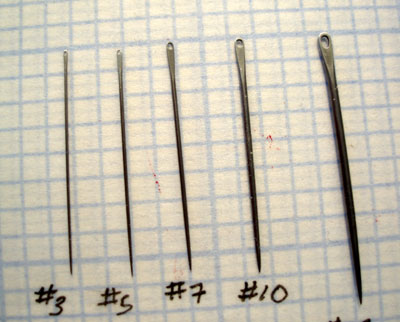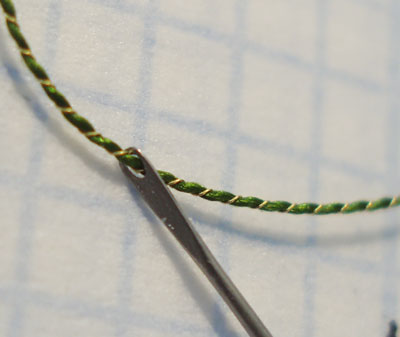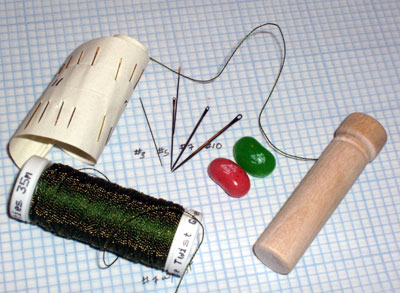Why would anyone want a hand-made needle? Surely, a hand-made needle must be some roughly hewn large thing unbefitting to fine embroidery work!! Well, you might think that, but the fact is, whether you pursue Japense embroidery or not, having a few hand-made needles among your embroidery tools is a good idea!
Although I have several books on Japanese embroidery, I have never formally studied the techniques, so my hand-made needles aren’t actually used in Japanese embroidery. These unique needles come in handy for working with real metal threads, with any smaller cord-like threads, and even just with your regular embroidery floss.
The advantage of hand-made needles is all in the eye. Because they are hand bored and not punched out by a machine, there is no “crimp” or ridge on the inside of the needle. The holes are nice and smooth.
This smooth round hole helps reduce the wear and tear on threads from the eyes of regular needles. With goldwork, this is important. You see, if you use a regular needle in goldwork (especially with gold-wrapped threads that you are planning to pass through the ground fabric), the ridge inside the edge of a regular needle can cut through the outside wrapping of gold on the core thread. When you pull the needle through the ground fabric, if your gold has split from the core, you risk the gold bunching up as you pull the thread through. Hand bored needles help you avoid this dilemma.
As for hand made needles being bulky or large, it depends on the size. The tiny #3 hand-made Japanese needle is so small that you can’t stitch one strand of DMC with it. If you split your strand of DMC in half (single strands of DMC are made up of a two-ply twisted thread), you can manage one ply (half the strand) in the eye, if you can see it to thread it! In other words, the #3 is a pretty small needle. So the hand made needles can be very tiny, but they can also be pretty large – able to accommodate gold passing thread easily.

Here, you can see the sizes of the hand-made needles I own. They are laid out on 8-square-per-inch graph paper. The #13 is large and has a bulky look to it. (It’s the one on the far right, with the number cut off.) The #3 on the left is pretty darned tiny!

This is the #7 needle, threaded with Gilt Sylke Twist. A #5 is too small for this thread, and I don’t have a #6 to try. I haven’t tried the thread yet with this needle, so I can’t say exactly how well it works! Once I get caught up with my regular work, I’m going to be testing different techniques with the GST. I figure the #7 needle will work fine for it. The #10 seems too big – as if there would be too large a whole left in the fabric after the needle and thread passed through. We shall see!!

Good things come in small packages! This is the dark green GST here – the “dusty” look on it is actually the sparke from the gold. Very nice color! And amazingly fine stuff!
You can find hand-made Japanese needles through the Japanese Embroidery Center in Atlanta. They are a valuable and reliable resource, and, if you do order from them, I think you’ll be pleased both with the products and the service.
I’m looking forward to playing with these needles and thread soon and posting the results for you! If you have any questions or any suggestions about any testing you’d like to see with the GST (“What kind of embroidery can you do with this thread?”) just let me know! I’ll be happy to see if I can accommodate any specific requests for trials.







Hey, Mary, A couple of comments regarding your very informative post: I do Japanese embroidery as well as other surface embroidery, mostly with silk. My #3 is machine made, though very small. It and the M4 have very fine, flat eyes. The biggest differences with european needles: the eyes are flat with large, round holes; the Japanese needles are made from carbon steel and should be kept in the wool they come in to prevent rusting, they are rounder and a little fatter than european needles, but should be kept very sharp. They pierce the fabric then make space for the thread to pass through. Japanese needles should be cleaned with very fine (I think 240) sand paper. You take a small square, fold it in half and pull the needle through it, turn the needle 90o and do that again so you get all sides. They are soft so you don’t want to rub on them. #10 is used for 4 strands of flat silk. The wide eye makes a large enough space for the silk to spread out. #13 are for sinking large, non-stitchable threads.
You should not use an emery strawberry to sharpen or clean them because it wears them down since they are soft. Mine have been very durable. They are about 8 years old (you tend to try to keep track of them at $8 each). I now use them for all surface embroidery I can. To thread them, I use a very fine threader I got from a fly fishing store. It is also Japanese, the wire is firmly attached and large enough and strong enough to pull through the eye of the needle. I hope this is all correct. It is mostly what I’ve been taught. Really enjoy the blog, Anneg
How do you properly sharpen a needle. (just the regular store bought kind, not the fancy kind)? I know that the little strawberry thing is for that but it doesn’t make sense to be because you still have to put it through the cloth of the strawberry. And how do you know when to sharpen? (maybe you arent’ supposed to at all?)
Hi, Heather – The emery strawberry is for sharpening needles. It’s the emery stuff on the inside (it’s kind of a gritty sandy stuff) that sharpens the needle. You just plunge the needle in several times to sharpen it. ~MC
You are the best!
You always have a lot the information thanks!
I would need to use 2 or 3 strands of DMC floss golden, perhaps I must use number 5 needle?
Hugs and love
Dear Mary, I am spending my first hours of the day enjoying the lovely pictures and interesting info I find on your site. Coincidental I would come across the article on Japanese handmade needles. I am in Tokyo for the year, and wondered if there were any particular Japanese tools I should bring back with me when I return home. I have a metal laying tool, but think I will buy another. Any other suggestions are welcome. Thank you for adding beauty to my life ! Cindy in Tokyo
Not so sure about tools, Cindy, but if you can get silk, you’ll sure to find some gorgeous silk fabrics and threads there! Also, goldwork threads! If you like doing goldwork, and nice pair of koma (wooden spools for winding gold threads on) would probably never go amiss! Enjoy your sojourn!
Hi Mary, what needle sizes do you recommend I buy? There are so many to choose from on the website. I noticed yours increase by 2.
Thanks for a great post!
Hi, Susanna – it depends on what you’re stitching. A variety pack of crewel size 3-9 or size 5-10 should see you through most situations!
Hi Mary, I’m thinking of buying a handmade Japanese needed for doing cross stitch. Which size holds two strands of DMC floss? Could I also use this needle for general embroidery as well? Thanks.
Hi, Susanna – I’m not sure Japanese needles would be ideal for counted cross stitch, since they’re quite sharp. I think a tapestry needle would be more suited. I’m afraid I don’t have my needles sorted by size, so although I could test the ones I have once I get them out, I don’t actually know which size needle is which with th Japanese needles. You might contact tha Japaense Embroidery Center in Atlanta – they can probably help you with sizing.
FYI, the Japanese Embroidery Center has informed us that they no longer have access to a good maker of handmade needles. They still have some in stock, as of today. They have developed a new ‘Hybrid’ needle, which we’re told is 80% machine made & 20% handmade. I’ve used these in Japanese Embroidery for the last couple of years, with good success. In fact, I prefer them over the handmade needles for some applications.
I see that this is an old post, but I was advised to use a Japanese needle for a pulled work project I am doing. I went to the Japanese Embroidery Center site but can’t find them there. Is there anywhere else I might purchase them? Thanks in advance for any help you can offer.
I’m responding to a query about how to purchase handmade Japanese needles. Go to jec store.com, Tools, Needles.
Enjoy!